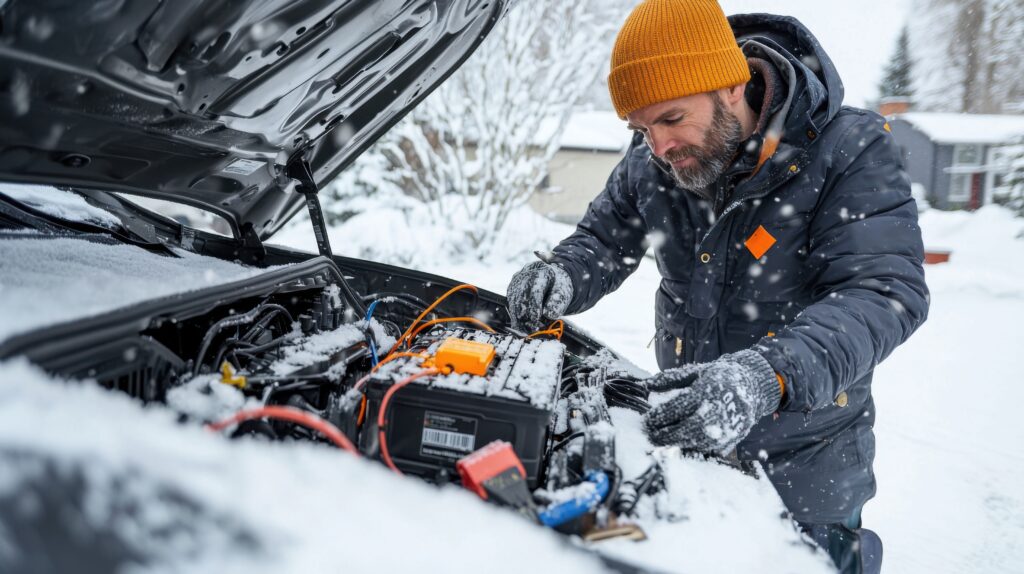It’s been another long winter workday and the temperature decided to take a sudden, unexpected nosedive between lunch and closing time—the weatherman’s “chilly” forecast apparently translated to “frigid.” The only thing standing between you and the warm sanctuary of home is a twenty-minute drive—or so you thought.
You rush to the car, brush a thin layer of frost off the door handle, slide into the frozen driver’s seat, and anxiously press start or turn the key and…nothing. Maybe you hear a weak click, or the engine tries to turn over once or twice before admitting defeat—either way, now you’re stuck in a freezing cold car, left with the option to either call a ride or a tow truck.

Sound familiar? You are far from alone. Cold starts—when your car struggles to start or is not starting when it’s cold—are one of the most common headaches drivers face when winter hits. It’s no surprise that calls to tow trucks and auto repair shops spike every year during the winter months. When the temperature drops, your car feels it too, which is why winter car maintenance is essential.
There are a few possible reasons why your car is not starting in cold weather—cold temps put added stress on a weak battery, can thicken or freeze fluids, and even affect the engine sensors. Let’s break down the different reasons why cold weather causes more engine trouble and how to prepare your car for winter so you can avoid potential cold start issues.
Cold Starts: Why Your Car Struggles to Start When Cold
Engines need three things to start: air, fuel, and a spark. As temperatures plummet, each of these key elements is affected:
- Battery strain: Cold weather reduces the battery’s ability to generate the electrical power needed to start your engine.
- Oil thickens: In freezing temps, engine oil thickens and doesn’t flow as easily. This makes it harder for the engine parts to work together.
- Frozen fluids: Excess moisture can freeze and cause blockages.
- Sensor malfunction: Cold conditions can disrupt sensor readings and cause starting issues.
Weak Car Batteries in Cold Weather
In cold weather, a weak battery is a leading cause of no-starts. When the temp is low, the chemical reaction inside your car’s battery slows down, which means it can’t produce as much power. On top of that, your engine requires more energy to crank in the cold.
So, does cold weather drain batteries? Unfortunately, it can—especially if the battery is old, weak, or not built to withstand your vehicle’s electrical demands. Combine that with the extra pull from heaters, defrosters, and seat warmers, and your battery may not have enough juice left to get going.
If your car has an Auto Start-Stop system, like many newer vehicles, the added pull from this alone can drain a standard battery quickly. These systems require specialized batteries with higher CCAs (Cold Cranking Amps) designed to handle repeated starts in cold conditions. Consider disabling the Auto Start-Stop feature when the temperature drops below freezing to avoid any unnecessary strain on your battery.
Additionally, if your car battery dies in the cold, it might not recharge properly. A jump-start could get you moving temporarily, but a weak battery will almost certainly fail again. If your car struggles to start when it’s cold, it’s time for a battery check.
Pro tip: Test your battery before winter hits. If it’s more than three years old or showing signs of struggle (slow starts, dim headlights, electrical flickering), replacing it early can save you from an unwelcome surprise at the most inopportune time.
Fluids Matter: Choosing the Right Winter Oil
Just like you layer up before heading outside, your engine needs additional protection, too. One of the best ways to safeguard it and avoid frequent cold starts is by switching to the right winter oil weight. Oil thickens in cold weather, so a lower-viscosity oil (like 5W-30 or 0W-20) flows better at low temperatures, keeping internal components lubricated and preventing damage during startup.
If you’re not sure what oil to use in winter, check your owner’s manual or ask your trusted mechanic at Rick’s Automotive. The right winter oil helps your engine start faster, reduces wear, and improves fuel efficiency.
Oil isn’t the only fluid that needs attention when the temperature drops. Other fluids to check beforehand include:
- Coolant/antifreeze—keeps your engine from freezing (and overheating). If these levels are low, it can cause major damage.
- Washer fluid—needs to be rated for freezing temps to ensure visibility. Regular washer fluid will freeze and be useless against removing frost, debris, or ice from the windshield.
- Brake fluid—old brake fluid can absorb moisture over time, leading to delayed or inconsistent braking.
- Transmission fluid—if it’s low or dirty, it can thicken in the cold and lead to sluggish or jerky shifting.
- Fuel: moisture build up in the fuel lines can freeze in extreme cold. A fuel additive designed to remove water can help keep things flowing.
Hidden Trouble: How The Cold Affects Your Engine’s Sensors
Today’s vehicles rely heavily on sensors to regulate fuel, air, and ignition timing. When the temperature plummets, these sensors can become less reliable. Condensation, ice buildup, or electrical resistance changes can lead to inaccurate readings. These misfires in communication may result in hard starts, rough idling, or failing to start altogether.
While less common than a weak battery or incorrect oil viscosity, sensor-related issues can cause significant trouble—especially in modern engines that rely on precise electronic feedback. If your car struggles to start in cold weather and you’ve ruled out the usual suspects, a faulty sensor could be the culprit. A professional winter engine check can help catch sensor issues early.
Preparing Your Car for Winter Checklist
When it comes to winter vehicle preparation, don’t wait until you’re stranded and freezing in a parking lot somewhere to think about it. Ensuring your car is winter-ready now can save you a tow bill—and a lot of frustration—later.
To keep your car running smoothly through the cold, start with these essential checks:
- Battery: Have your battery tested and replaced (if weak)—ensure it has high enough CCAs to handle the electrical load needed for your vehicle.
- Motor Oil: Switch to the recommended winter oil weightto avoid over-thickening.
- Antifreeze: Check antifreeze level and top it off (if low).
- Washer Fluid: Replace regular washer fluid with an All-Season or Winter washer fluid.
- Belts & Hoses: Inspect belts and hoses—the cold can cause these to crack if they’re worn.
- Sensors: Have sensors checked for potential issues
- Tire Pressure: The cold reduces PSI, so you’ll need to fill them with air once the temperature drops.
- Tire Tread: Check the tire tread to ensure proper grip for hazardous winter conditions and replace them if they are worn.
These quick checks not only help your car start and run smoothly through the cold months—they also protect its critical components from costly winter damage and help keep you safe on the road.

Don’t Let Winter Catch You Off Guard
Winter doesn’t have to mean constant cold starts or unexpected breakdowns. A little winter car maintenance now can help ensure you’re ready for whatever Mother Nature throws your way. Get ahead of the cold. Book a winter engine check with Rick’s Automotive today. Our certified technicians will inspect your battery, fluids, and engine systems to make sure your vehicle is ready for the season, so you can drive into winter with confidence.
